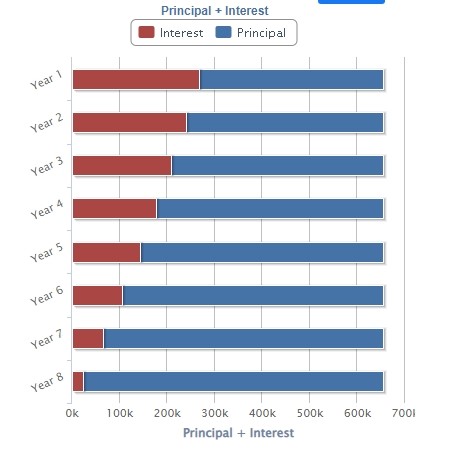The biggest bottleneck for students who want to study abroad is funding.
The cost of tuition for a two-year MS course at a top US university may reach $50,000. That amount is excluding the cost of living for two years ~$30,000.
$80,000 is ₹60 lakhs (at ₹75 to the dollar), a rather vast sum for most students and their parents.
The obvious solution is to take an education loan for study abroad. But there’s competition there too.
The number of Indian students studying abroad is growing.
The latest data from January 2021 shows that at least a million of them are engaged in pursuing college and university degrees away from their home.
According to the MEA, 261,406 went abroad in 2020. It hit a road bump because of Covid and went down to 71,769 last year but is expected to go back up in 2022.
This guide helps you understand:
- how you can prepare yourself for the education loan search process
- the factors that influence whether you’ll get an education loan to study abroad
- the basic eligibility criteria for an education loan
- the documents you’ll need when you apply for an education loan to study abroad
- the key terms that you need to know during the search process
We examine every aspect of the process and guide you through the pitfalls.
Education Loan – Basic Eligibility Criteria
| Nationality | Indian |
| Nationality of co-signer | Indian |
| Age Bracket | 18 years and above |
| Academic Record | Good score in preceding examinations |
| Admission Courses | Graduate, Post Graduate, Ph.D. |
| Admission Status | Confirmed |
| University Status | Recognized (ideally among the top 500 universities in the world) |
Education loan – Documentation
- Duly filled out loan application form
- Copy of admission letter
- Passport Photos
- Residence Proof – Voter Card, Passport, Aadhaar Card
- Photo ID Proof – Aadhar Card, Drivers License
- Age Proof – PAN Card, Birth Certificate, Class X Certificate
- Recent salary slips of co-signer
- Recent ITR of co-signer
- Recent bank statement of co-signer
- Recent Form 16 of co-signer
- If the co-signer owns a business then the recent P/L Account and Balance Sheet in lieu of Form 16.
4 key factors you must consider while taking an education loan
An education loan to study abroad is a step in the right direction. Not only does it provide you access to the best educational institutions and the finest teachers, but also the highest paying jobs.
But a loan has to be repaid. The slightest error in judgment could end up costing several lakhs a few years down the line.
What must you look for in an education loan for study abroad?
1. Tenure
How long would the education loan for study abroad last? How long do you have to repay? The duration is known in banking parlance as tenure.
Banks rarely lend for a period above fifteen years. Thus if you avail of the loan at 20, you have till 35 to pay it off.
Should you opt for a long tenure or short? That depends on how much you can afford to repay.
What you specialize in and the average starting salary plays a large part in your decision.
If you are starting in software, your salary could be as high as $120,000 when you take your first job.
For a postgraduate in biosciences, that is nearer $50,000. That is a colossal difference and would certainly factor in your decision-making.
Should I not always opt for a longer tenure?
No.
A long tenure means more months of borrowing and consequently a greater amount paid as interest.
At 10%, the interest would equal the principal in 7 years. Any longer and you are paying back more interest than what you borrowed in the first place.
You need expert help in making this decision. FundRight has experts who would guide you through the decision-making process.
Build your profile and access 100% free, reliable, unbiased, and specific advice that helps you choose the right university, the right scholarship, and the right education loan.
2. Moratorium
A student can’t start to repay the education loan for study abroad the month after he receives it (as is usual with home and auto loans).
He would need to first complete his education and then find a job.
For many, this would include many months as an intern with little pay.
That is why education loans have a moratorium period.
During this time, the student does not have to pay any installments.
That does not mean the principal is not getting charged with interest. Only that no repayment is being asked.
A moratorium can again be of two types—principal moratorium and interest moratorium.
The first means no principal has to be repaid. The student has to repay the interest component.
The second means a total moratorium.
Be clear about which type you are being offered. If it is a principal moratorium, then your parents might have to pay interest while you are studying. For some families, that might be a burden.
3. Interest Rate
Banks charge interest based on the reverse repo rate. It is the rate that RBI charges when it lends money to commercial banks.
Banks add on their overhead, profit margin, and also a risk margin (for non-recovery) and sell you the loan.
Currently, the reverse repo rate stands at 3.35%. Banks lend at rates between 6.5% and 11%.
Choose between fixed and floating rates depending on your ease of repayment and financial condition.
A fixed-rate interest would never vary during the loan tenure.
A floating rate would change once every quarter, depending on the prevailing reverse repo rate.
The fixed-rate seems more attractive since you know your total outgo the day you sign the loan. But a floating rate lets you take advantage of low-interest rate regimes.
If you opt for a fixed-rate education loan for study abroad, it would be at least 400 basis points above the floating rate. But many prefer it since it brings certainty.
4. EMI
Equated Monthly Installment is the payment you will make to the bank every month.
There are two ways in which EMI calculation happens.
I. Fixed Installment
This is rather easy to understand. The loan principal and the entire interest are calculated. The amount is divided by the number of months the loan will be repaid.
Sohail takes an education loan for study abroad of ₹40 lakhs in 2020.
The interest rate is 7% every year, and the tenure is 10 years. Repayment would begin after a 2-year moratorium.
The total amount to be paid back:
₹4,000,000 (principal) + 2 * 0.07 * ₹4,000,000 (interest during moratorium) + 8 * 0.07 * ₹4,000,000 (interest during repayment) = ₹6,800,000.
EMI = ₹6,800,000 ÷ (12 * 8) = ₹70,833.
This would always be greater than reducing the balance EMI. Let’s see how.
II. Reducing Balance
Assume you take a loan from the bank you pay back with an EMI.
The installment contains a part of the principal and a part of the interest. The principal, therefore, reduces as you pay for years.
Since the principal reduces, the overall interest burden also goes down substantially.

We cannot calculate it with an easy formula. However, you can find plenty of EMI calculators on the net.
If Sohail repaid the above by reducing balance, the monthly outgo would reduce substantially.
Assuming ₹4,000,000 (principal) + 2 * 0.07 * ₹4,000,000 (interest during moratorium) = ₹4,560,000 is the total outstanding when Sohail begins repayment.
Reducing Balance EMI would be about ₹62,170.
Fixed interest vs. Floating and the type of EMI can get really confusing. Get professional advice from the team at FundRight and be sure that you are not going to end up paying more in the long run.
4 factors banks consider while granting an education loan
The education loan market is complex. It is quite tough to receive a loan unless you meet stringent criteria.
You need to understand why it is so painstaking.
Indian banks are flush with funds. Yet they scrutinize every loan application with a microscope.
That is because they are afraid of Non-Performing Assets which is banking lingo for people who did not pay back their loans.
NPA reflects on the permanent record of a bank manager, and thus they are careful. No one can blame them for ensuring they get the overdue promotion or salary hike.
You can make it easier for them to grant you a student loan for study abroad.
What do they look for?
1. Credit History
If you are asking for a bank loan for education, ensure that you have a spotless credit history.
But can you have a credit history if you are only 20? Yes, absolutely. It makes sense to work towards it from your eighteenth birthday (when you become old enough to take a loan).
Get a postpaid mobile connection. Pay the bills by the due date.
If you use app-cabs, opt for rides with a service that offers a postpaid scheme. All you need is to provide a PAN number for basic KYC.
And the best way, ask your parents to get you a credit card in your own name.
Quite easy to get one if you make a fixed deposit and ask for a card in return. A ₹1 lakh FD will be enough to get you a card with a limit of ₹70,000. Make purchases and pay them back within the due date without fail. In a year, you would have a credit rating of at least 800 (out of a possible 900).
Demonstrating to a bank that you have repaid a loan of ₹5,000 exactly on schedule is better than zero credit history.
2. Universities
Banks like the education loan process to be simple. That cuts down the manpower and time involved.
That is why they maintain a list of pre-approved universities. There is no possible way of knowing which institutions they approve but it is safe to say that the top 300 universities make the cut.
What does not make it to the list?
- Community colleges are the first to be left out. These are higher education institutions in North America that offer simplified two-year courses.
- The other is educational institutions in lesser-known places, mostly erstwhile Communist Bloc—Latvia, Lithuania, etc.
If you are applying for a 4-year undergraduate course or a 2-year post-graduate course or a Ph.D. in any of the well-known universities and colleges, there is nothing to worry about.
3. Repayment Capacity
The bank does not care if you are a brilliant student. Of course, that helps your cause but does not address their chief concern—will you be able to repay the loan?
If you scored above the 98 percentile in the Joint Entrance Examination, did M.Tech from IIT, Kharagpur, took a ₹50 lakhs loan, and end up with a Ph.D. from MIT in the preservation of water table in tropical climatic zones, your first job would probably be with an NGO.
You would finally end up as an IAS officer in the Ministry of Water Resources, River Development, and Ganga Rejuvenation.
In the best-case scenario, you will become a tenured professor at a European university by age 40.
That does not inspire confidence in lenders who want you to repay fast.
But if you did an undergraduate degree in Data Science from Berkeley, you would probably head to a Wall Street investment bank or at least Amazon HQ in Seattle.
A salary of $100,000 and a sizable signing bonus, at age 22, is not out of the question.
No prizes for guessing whose education the bank would like to bet on.
4. Collateral and Guarantor
Banks like to be sure that someone or something will pay them back. That is why they want assets in place of the loan.
With a home loan, the home itself is the asset they hold. Same for cars and bikes.
But with education, that is not possible.
Hence, they want collateral, such as a house or non-agricultural land.
In case you default, they would sell off the asset and recover the investment.
Which collateral do they like most? A fixed deposit of the amount they are loaning out.
They can access it with no problem, and the cost of liquidation of assets is minimal.
Banks like to call a guarantor a co-signer.
A co-signer is usually a person who is a relative (parents, parents-in-law, or spouse) and promises to repay the amount due if you default.
Of course, they need to show a source of income that would allow them to do so.
Banks would want collateral, a guarantor, or both, depending on the case.
Every bank has separate criteria in this matter.
FundRight – the easy way to get a loan to study abroad
So many banks with so many different rules. A riddle, wrapped in a mystery, inside an enigma.
Some would want collateral and some might replace it with a guarantor but some others would prefer a guarantor who has a secure job and does not work as a lawyer (believe it or not that is an unspoken criterion at many banks).
Why not log in to FundRight and create a profile. Our network of domestic and international lenders is increasing every month. Remember, when lenders compete for your loan, you get the best terms.
Let the lenders bid for your loan instead of cooling your heels in one bank lobby after another.
You would have to wait for several weeks to avail of a loan ordinarily. With FundRight that is cut down to as little as a couple of days.
Your data is safe and secured on FundRight. No one would harass you with spam messages asking if you would like a home or car loan.

3 FAQs on getting your best education loan to study abroad
A. Are unsecured loans possible?
Indian banks cannot provide unsecured loans above a few lakhs.
Those who have a well-paying job can get a credit card with an ₹4 lakhs limit, but that comes with a usurious interest rate of 48% per year.
Needless to say, such a rate would make your loan of ₹30 lakhs into a crore before you emerge from the moratorium period and start earning.
That is not to say private lenders can’t give unsecured loans.
You have to research and find out if any such lenders are available. But be prepared to pay more interest because unsecured loans have a heavy default rate and other customers must make up the shortfall.
To know more about collateral v/s non-collateral loans, read our guide.
B. Does the guarantor need an ITR?
Yes, they require an ITR for several years. This is to demonstrate that they have a steady source of income.
C. Can I get a student loan for study abroad without a guarantor and collateral?
If you are asking a financial institution registered as a bank under RBI, then no. Banks have to adhere to national and international laws while lending.
That does not mean a private lender or an NBFC or a crowd-funded site cannot fund such a loan.
Summing it all up…
Education abroad opens up career possibilities that just are not present in India. Studying abroad can mean a work visa later on. Employers find it easier to sponsor those who are already abroad.
For those in STEM, universities abroad have funding and equipment that no Indian university has. An affordable student loan for study abroad is all that stands between you and your dreams.
Let FundRight help you have easy access to an education loan for study abroad.





